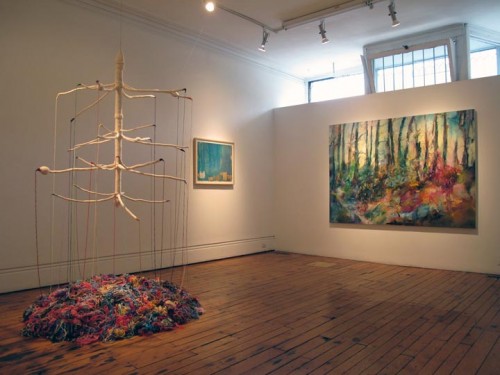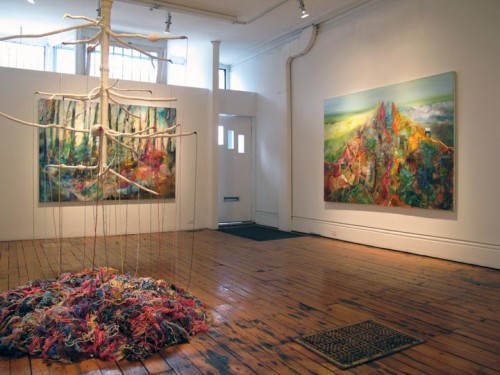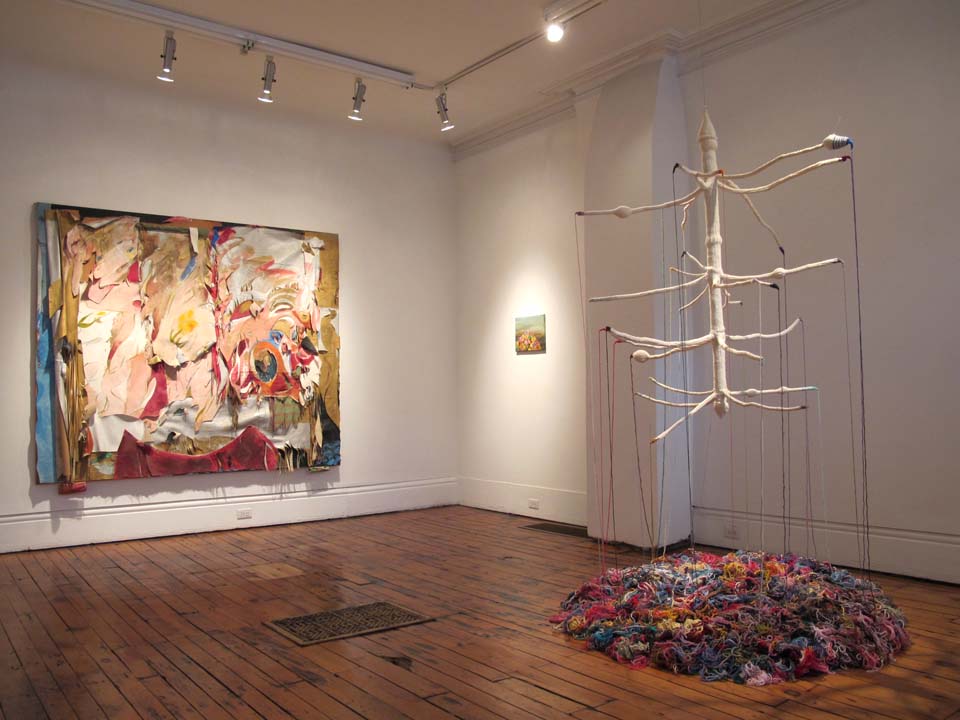Crossing Natures
Yvonne Housser, Janet Morton, Mélanie Rocan, Joyce Wieland
October 14 - November 12, 2011

Crossing Natures is a group exhibition that explores a lineage of feminism, and cross-generational influences and affinities, in contemporary Canadian art found in the work of Joyce Wieland (1931-1998) and in the work of two younger generations of Canadian artists, Janet Morton and Mélanie Rocan. We are also pleased to include a painting from 1948 by Yvonne Housser (1897-1996).
Crossing Natures also looks at the idea of thresholds that convey aspects of our relationship to nature and how this relationship is portrayed in the work of these artists.
Special thanks to Michael Ondaatje and to Nell Tenhaaf for her text, Soft In The Head (2011).
from Divisadero (2007) by Michael Ondaatje:
"There were evenings when Aria and Rafael stood on the dry night-grass with a hundred layers of stars above them. Uncountable. A million orchestras. The boy could scarcely store the delirious information. That journey south with his mother and the return north broke his heart again and again with happiness. It was when he felt most clearly that there was no distinction between himself and what was beyond him - a tree's sigh or his mother's song, could, it seemed, have been generated by his body. Just as whatever gesture he made was an act performed by the world around him." p. 184.
"The woman's figure is naked from the waist up, moving forward, just about to break
free of focus. The tanned body willful, laughing, because she has woven the roots of
two small muddy plants into her blond hair, so it appears as if mullein and rosemary
are growing out of the plastered earth on her head. There's a wet muck across her
smiling mouth, and on her lean shoulders and arms. It is as if her energy and
sensuality have been drawing from the air surrounding her." p. 186.
(Toronto: Vintage Canada Edition 2008)
Soft In The Head, by Nell Tenhaaf
At the outset of this essay I was reading The View From Castle Rock, Alice Munro’s historical/autobiographical account of her Laidlaw ancestors and, in particular, how that history shaped her farm upbringing in Southwestern Ontario in the 1930s and 40s. The family came to Canada in 1818 as pioneers, and as such they had to first fight nature for their survival. Later, as established farmers, they were still threatened by the elements and Munro comments that they built their farmhouses with little view to the outside so as to see nature less rather than more. Throughout the book Munro identifies with the ordinary country folk that she grew up among, but she remarks about those days that “People who openly admired nature – or who even went so far as to use that word, Nature – were often taken to be slightly soft in the head.” (1) She herself was one of these soft in the head types. (Here Munro deftly moves from nature to the capitalized Nature, and I mean the difference in the same way that she means it: Nature is any philosophical conception of what is otherwise the natural surround.)
Like Munro, I come from a farming family. This may explain why her comment resonates so strongly with me, in the way that it describes a young person’s experience of tension between the affinity one feels for the values of one’s people and a divergence from those values through finding beauty and spirituality in the natural world – any aspect of the natural world. Even at the time I sensed that this approach to nature was rather pantheistic, which not only fed my breaking away from family values that were defined by religious ties, but also – as Munro goes on to describe it – seemed to be connected in some way to an emerging artistic sensibility.
This entire dynamic is captured in Yvonne Housser’s Spring In The Studio of 1948. Although Housser was one of the urban people who Munro eventually discovered she felt much more comfortable living among, she clearly loves nature as a kind of muse. And she clearly locates us in the countryside in this painting. Through its curtained window frame it allows us to look out onto a swatch of cultivated land, not onto the great North of the Group of Seven whose images by that time exemplified the spirit to be found in the forms and patterns of Canada’s still raw terrain. The planes in Housser’s painting are highly artificial: the front one conjoins a vase of flowers with a curtain that we look past and through, then there is the strange flattened plane of trees in the middle ground, and finally the upright row of bush meeting sky in the back. Together they allow the viewer to float into the scene, over an oddly askew stretch of ordinary land that appears to be an orchard, but here has acquired a magical power of stillness. What Housser shares with all art about Nature is its irony, in that it is premised on artificially fashioning something that essentially precedes artifice and is outside our comprehension. Spring In The Studio is suffused with a nature/artifice tension: one could say it allows both conjoining with and non-comprehension of nature to fully breathe.
Fast forward forty years to 1988, the date of Joyce Weiland’s Entrance To Nature, with an update on my own perceptions of nature. The American ecofeminist Carolyn Merchant had published her landmark book The Death of Nature eight years earlier. I didn’t become aware of it until around 1990, when my interests in the intersection of feminism and biology had come to the surface. In the academy and the part of the artworld that it intersected with, there was indeed a current in the air about the controlling and reductive instruments of (masculine) technoscience dulling, if not killing, the dynamism in nature. That this perspective altered, but did not wipe out, the previous generation’s optimistic view about the natural world is one way of understanding the exhibition theme and title, Crossing Natures. Merchant’s contribution to philosophy was to have a far-reaching influence and prove itself visionary in articulating how we have tamed, managed, objectified, atomized, and rationalized Nature. Her feminist argument was visionary at the time – today it matters less which gender is responsible for the ever more rapid disappearance of Nature as a powerful and compelling force. It seems more important to reclaim that power in any way that we can.
For this reason it is striking to see in Mélanie Rocan’s very recent painting Secrets images of being united with nature in the form of rituals that are definitely pagan and probably also pantheistic, invoking redemption through immersing in and conjoining with the natural world. And in Janet Morton’s She's Come Undone the suggested ability to put back together what has come almost, but not entirely, asunder is as comforting as the pile of wool heaped on the floor. Interestingly, each of these artists leans toward abstraction in her own way. Rocan buries her figures within brushstrokes that speak to the Abstract Expressionists’ mantra of locating truthful experience in the paint itself, as both surface and gesture. Morton invokes AbEx painterly power in a similar way, for the authenticity of its rebellious energy. Again, the artifice of an artwork – including its abstractness – can appear to be the furthest thing from Nature, yet connect with its spirit and even stand in for it, because the work exists in and of itself without extrinsic justification. A work of mine that is currently in progress, WinWin, shares this spirit of reinstating nature’s power – in the case of this work, by way of coming out the other side of technoscience, in a sense. WinWin sets up an interactive relationship between the viewer and dynamic imagery of nanoparticles acquired through high-powered microscopy (or nanoscopy). When one interacts with the work, this quasi-representational imagery is no longer inside or outside oneself, but in some way both.
Returning to Weiland’s large floppy painting, it seems to be asking how it is possible to still (even at that time) enter nature. And it proffers some answers to the question: by bird, by canoe, by identifying with the knowledge of aboriginals, by all of these intertwined. The bird has a complicated role: the artist first splayed a body open on a canvas à la Rubens-like flesh, with a bird trying to pull it up out of its earthbound massiveness, which it can’t do. But that image has been ripped up and re-attached to the painting’s support, and the bird is pulling upward the flesh – along with an embedded Indian head – and turning it into flowing parts with buckskin fringes. This painting is so gloriously soft in the head in the face of a Nature that has been hyper-rationalized, that it has to have the last word.
Nell Tenhaaf is an electronic media artist, writer and full-time professor in the Visual Arts Department at York University in Toronto. Her exhibition WinWin is scheduled for April 2012.
1. Alice Munro, The View From Castle Rock (Toronto: McClelland & Stewart Ltd., 2006), p.288.
Fran Schecter
NOW | October 27-November 3, 2011 | VOL 31 NO 9
R.M. Vaughan
Globe and Mail | Saturday November 5, 2011
Top 10 Art Shows 2011
NOW | December 22-29, 2011 | VOL 31 NO 17







